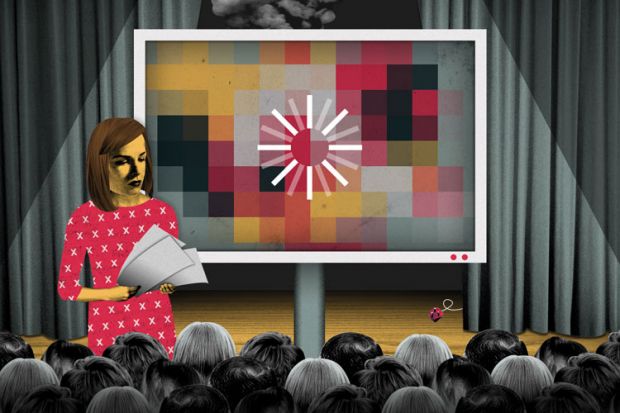Source: Nate Kitch
We’ve all been there: sitting in a stuffy conference room as a speaker is introduced and prepares to present a paper. Then – here we go again – some part of the audio-visual system won’t cooperate. Minutes pass as attempts are made to fix things. But it could be worse – the speaker could be us.
The audience response to such incidents, which are too frequent to be really surprising, generally moves through phases. First of all, there is continued hopeful expectation. Then, after a few minutes, there is a clear move to “time out”: conversational levels increase and people resort to the ever-present possibilities afforded by their mobile devices.
If no resolution seems in sight, some at the back may choose to creep away, perhaps to another session. The event may be rescheduled, or someone will suggest a short break. All the while the unfortunate speaker, just a few minutes ago eagerly anticipating that moment in the spotlight, continues to run through possible remedies – including, perhaps, those shouted out from the floor.
They might also be aided by a diffident member of the host department (“I’m afraid I never use this room myself”) or even a technician (“This has never happened before”). Speakers subjected for too long to this kind of intensifying pressure may finally feel that a possible loss of enthusiasm by the audience is of less significance than their own complete loss of interest in delivering their paper.
The inclusion of audio-visual material has become a routine part of academic speaking in lectures and conference sessions. Although it remains open to the risk of the “show” taking over from the talk, it has brought increased clarity and helpful illustration. For some speakers, it also presents the opportunity to use image, sound and video extracts to provide examples around which their exposition and analysis can be developed. However, the price to be paid for these advantages is a degree of dependence upon technology that is reliably unreliable.
Problems with audio-visual technology have always existed. Even with simple VHS tapes, the appearance of decent sound and vision when you pressed “play” was not something that could be assumed so readily that it didn’t bring a flood of relief when it happened. And the matter of whether the sound and vision that you got was the particular bit that you wanted, warranted some care. I remember an incident before a public lecture in Norway when, after carefully setting up my tape for the precise three minutes of the film I wanted for the opening of my talk, I went to the toilets. When I returned, a technician had arrived, who told me that he had checked the player and had rewound my tape to the start so that it was now ready when needed.
At one conference, I was reduced to providing a roughly remembered commentary and interview exchange for about four minutes of what had been turned by the equipment into a silent documentary on nuclear energy. Appreciation was duly shown, but I would have rather it had been for the interest of my analysis than for my excursion into performance art. At another event, I recall a humble slide carousel turning treacherous, repeatedly popping the speaker’s slides into the air like tiny pieces of toast as the drum was rotated. At first, he reacted with good humour, passing it off like the comic mishap in a Tommy Cooper trick, but as the malfunction continued and a smell of burning became apparent, he got increasingly angry at the sight of his presentation almost literally going up in smoke.
These days, the sheer complexity of some lecture room consoles, rivalling air traffic control desks, is an even greater source of anxiety. Those who have grown up with digital technology are certainly likely to be less worried by it than those who have come to it late. But while I know that younger researchers produce far more ambitious and engaging audio-visual materials than I do, my sense is that, on the day, their vulnerability to mishaps is not much different from anyone else’s.
Perhaps the ongoing development of kit and software will reduce the frequency of glitches – although “upgrading” has been the cause of some of them. But, for the foreseeable future, conference organisers will need to ensure that thorough pre-testing of equipment is carried out if the currently rather ridiculous rate of disruption is to be reduced.
Quite a few presentations can convert to “talk only” without too much loss – even a bit of gain. But when planning to show examples, I shall certainly continue to have a plan B on standby – which goes beyond unhappily describing to the audience what they have missed.
Register to continue
Why register?
- Registration is free and only takes a moment
- Once registered, you can read 3 articles a month
- Sign up for our newsletter
Subscribe
Or subscribe for unlimited access to:
- Unlimited access to news, views, insights & reviews
- Digital editions
- Digital access to THE’s university and college rankings analysis
Already registered or a current subscriber? Login





